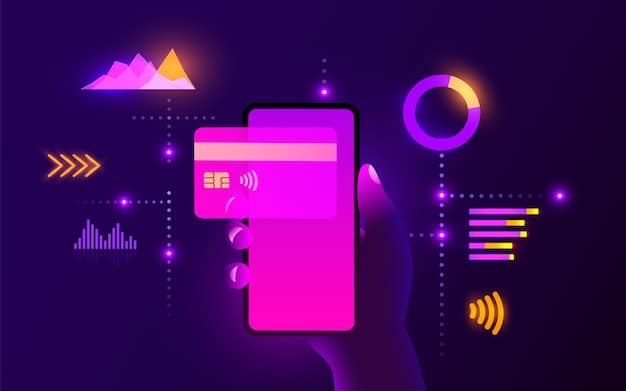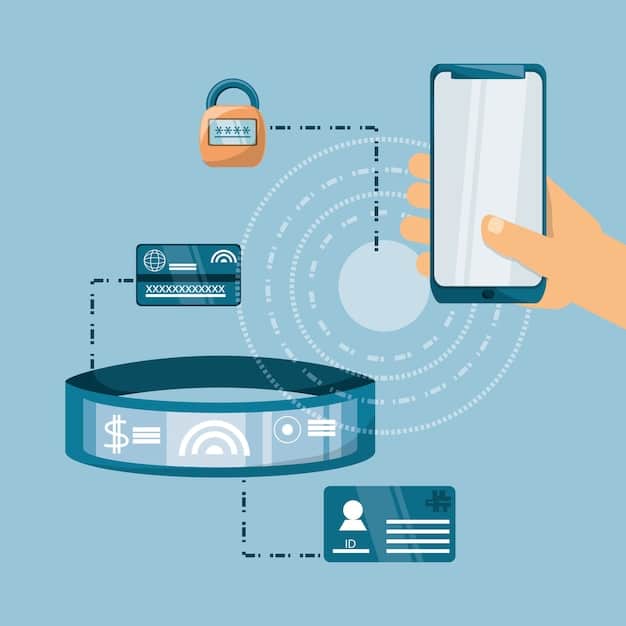Contactless Payments in US E-commerce: Trends & Opportunities for 2025

The future of contactless payments in US e-commerce for 2025 points towards greater adoption, enhanced security, and seamless integration across various platforms, driven by technological advancements and changing consumer preferences.
As we approach 2025, the landscape of e-commerce in the US is undergoing a rapid transformation, with the future of contactless payments in US e-commerce: trends and opportunities for 2025 taking center stage. Exploring these shifts helps businesses and consumers prepare for the evolving financial era.
Understanding the Rise of Contactless Payments
Contactless payments are changing how Americans shop online. They offer speed, convenience, and enhanced security, drawing more users every year. This section explores why these payments are becoming so popular in the US e-commerce sector.
Several factors contribute to this rising popularity.
Enhanced Security Measures
Contactless payments employ advanced encryption and tokenization methods. These technologies protect sensitive payment information, reducing the risk of fraud. For consumers worried about online safety, this is a big advantage.
Convenience and Speed
Contactless transactions are quick and easy. Customers can complete purchases with a simple tap or scan, skipping the need to enter card details manually. This streamlined process improves the overall shopping experience.
- Faster checkout times reduce cart abandonment rates.
- Seamless integration with mobile wallets enhances user convenience.
- Contactless payments minimize physical contact, addressing hygiene concerns.
The growth of contactless payments is not just a trend; it’s a fundamental shift in how consumers interact with e-commerce.

Key Trends Shaping Contactless Payments in 2025
Looking ahead to 2025, several key trends are set to shape the future of contactless payments in the US e-commerce market. Understanding these trends is crucial for businesses aiming to stay competitive and meet evolving customer expectations.
Here are the most important developments.
Increased Adoption of Mobile Wallets
Mobile wallets like Apple Pay, Google Pay, and Samsung Pay are becoming increasingly popular. These platforms offer a secure and convenient way to store and use payment information. Their seamless integration with smartphones makes them a preferred choice for many shoppers.
Biometric Authentication
Biometric authentication methods, such as fingerprint scanning and facial recognition, are enhancing the security of contactless payments. These technologies provide an additional layer of protection, making transactions safer and more reliable.
Integration with IoT Devices
The Internet of Things (IoT) is expanding the reach of contactless payments. Smart home devices, wearables, and connected cars are enabling new payment opportunities. Consumers can make purchases directly from these devices, creating a more integrated shopping experience.
These trends indicate a move towards a more seamless and secure payment environment, revolutionizing the e-commerce landscape.
Opportunities for E-commerce Businesses
The rise of contactless payments presents numerous opportunities for e-commerce businesses. By embracing these payment methods, companies can enhance customer satisfaction, increase sales, and gain a competitive edge. This section explores the key benefits and strategies for implementation.
What advantages can companies expect?
Improved Customer Experience
Contactless payments streamline the checkout process, making it faster and more convenient for customers. This leads to a better overall shopping experience, increasing customer loyalty and repeat business.
Reduced Transaction Costs
Contactless payments often have lower transaction fees compared to traditional payment methods. This can result in significant cost savings for e-commerce businesses, especially those processing a high volume of transactions.
Enhanced Security and Fraud Prevention
Contactless payments offer enhanced security features, reducing the risk of fraud and chargebacks. This protects both the business and its customers, building trust and confidence in the payment process.
- Offering multiple contactless payment options caters to diverse customer preferences.
- Optimizing mobile checkout processes improves conversion rates.
- Leveraging data analytics to understand customer payment behavior enhances targeted marketing efforts.
By leveraging these opportunities, e-commerce businesses can thrive in the evolving payment landscape.
Challenges and Considerations
While contactless payments offer many benefits, e-commerce businesses must also be aware of the challenges and considerations involved. Addressing these potential issues is crucial for successful implementation and adoption.
Potential roadblocks include:
Security Concerns
Despite the advanced security features of contactless payments, some consumers remain concerned about potential fraud and data breaches. Educating customers about the safety measures in place can help alleviate these concerns.
Infrastructure Costs
Implementing contactless payment systems may require investments in new hardware and software. Businesses need to evaluate these costs and ensure they align with their budget and long-term goals.
Integration Complexities
Integrating contactless payment methods with existing e-commerce platforms can be complex. It requires careful planning and technical expertise to ensure a seamless and secure integration process.

Understanding these challenges allows businesses to make informed decisions and mitigate potential risks.
Strategies for Implementing Contactless Payments
For e-commerce businesses looking to implement contactless payments, a strategic approach is essential. This section outlines the key steps and best practices for successful integration and adoption.
Here’s what you need to do.
Choose the Right Payment Gateway
Selecting a reliable and secure payment gateway is crucial. Ensure the gateway supports the contactless payment methods you want to offer and provides robust security features.
Optimize Mobile Checkout
Mobile devices are increasingly used for online shopping. Optimize your mobile checkout process to make it fast, easy, and secure for customers using contactless payments.
Educate Your Customers
Inform your customers about the benefits and security features of contactless payments. Provide clear instructions on how to use these payment methods and address any concerns they may have.
A well-planned implementation strategy can pave the way for a successful and beneficial transition to contactless payments.
Future Predictions for Contactless Payments
As we look further into the future, several predictions can be made about the evolution of contactless payments in US e-commerce. These insights can help businesses prepare for the changes ahead and capitalize on emerging opportunities.
Expect these developments:
Wider Adoption Across Industries
Contactless payments are expected to become even more widespread across various industries, including retail, hospitality, and transportation. This will create a more seamless and integrated payment experience for consumers.
Advancements in Security Technologies
Security technologies will continue to evolve, with new innovations aimed at further protecting contactless transactions. This includes the use of artificial intelligence (AI) to detect and prevent fraud in real-time.
Personalized Payment Experiences
E-commerce businesses will leverage data analytics to create personalized payment experiences for their customers. This includes offering customized payment options, loyalty rewards, and targeted promotions based on individual preferences.
The future of contactless payments is bright, with ongoing innovation and increasing adoption driving its continued growth and success.
| Key Point | Brief Description |
|---|---|
| 🚀 Mobile Wallets | Increased usage of Apple Pay, Google Pay, and Samsung Pay. |
| 🔒 Biometrics | Fingerprint & facial recognition for enhanced security. |
| 🌐 IoT Integration | Payments via smart devices & connected cars. |
| 🛡️ Enhanced Security | Tokenization and encryption to protect transactions. |
Frequently Asked Questions
▼
The convenience, speed, and enhanced security features are key drivers. Increased mobile wallet usage and integration with IoT devices also contribute to growth.
▼
Mobile wallets use tokenization and biometric authentication, protecting sensitive payment details by replacing them with unique, transaction-specific tokens.
▼
Challenges include security concerns, infrastructure costs, and integration complexities with existing systems. Addressing these requires careful planning and expertise.
▼
Businesses can streamline the checkout process, offer multiple contactless options, and ensure their mobile site is fast and user-friendly. This enhances conversion rates.
▼
Expect advancements like AI-driven fraud detection, enhanced biometric authentication, and more robust encryption methods to further secure transactions.
Conclusion
In conclusion, the trajectory of contactless payments in US e-commerce points to a future characterized by increased adoption, enhanced security, and seamless integration. E-commerce businesses that proactively embrace these trends and address associated challenges will be best positioned to thrive in the evolving digital marketplace.





